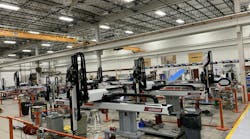By Karen Hanna
Manufacturers that have struggled to find workers could benefit from widening the aperture through which they view the labor pool.
For Bob Hersh, national managing principal of manufacturing for Grant Thornton’s New York and New England business advisory services, the efforts start at home, with better outreach. As he likes to say, “We’re not your grandfather’s manufacturing industry."
According to the U.S. Chamber of Commerce and Stephanie Ferguson, who serves as the organization's director of Global Employment Policy & Special Initiatives, possible targets for recruiting could be people who have been recently released from prison or jail, military spouses and other people with gaps in their resumes — a common phenomenon in light of the COVID-19 pandemic, which forced many people from the workforce.
“Especially with military spouses ... this group of people will often have those gaps in employment history ... or they've moved around a lot. That's true as well ... with folks that have been formerly incarcerated will have a gap on their resume. These are folks who, while perhaps on paper those gaps may not be very appetizing to an employer, our HR professionals [who have done the] same survey time and time again [found] that individuals in these buckets perform just as well, if not better, than their other peers at work,” said Ferguson, who touted the U.S. Chamber of Commerce Foundation's Hiring Our Heroes program, which connects the military community with businesses.
“Certainly, she said, “take advantage of anybody who’s really eager to enter into the workforce.”
Other oft-overlooked groups include people who are neurodivergent or have disabilities, Ferguson said.
She said tax credits are available to companies that hire people who represent certain demographics.
In his home state of Connecticut, Hersh is active in efforts to reach out to high school students about opportunities in manufacturing.
“We’ve got to get more creative in how we go after that population, and not just rest on the laurels of what we’ve done in the past,” he said.
“It demands a broader, more diverse, creative, maybe more educated workforce."
In its role in the LIBERTY Campaign, the Chamber is looking beyond national borders, lobbying for immigration reforms that could help fill certain jobs. LIBERTY stands for Legal Immigration and Border Enforcement Reform This Year.
The LIBERTY Campaign calls for greater border security, as well as higher caps on visas for immigrant workers who could perform in-demand, essential and non-seasonal jobs.
Like other demographics associated with the labor pool, the number of individuals with lawful permanent resident status is in decline, due to what the Chamber calls a “woefully inadequate immigration system.”
Citing U.S. Census data, a Chamber report states: “Net international migration to the U.S. only contributed to a 247,000-person increase to the U.S. population between 2020 and 2021. Compared to the prior decade’s high of a 1,049,000 increase in our population between 2015 and 2016 due to immigration, the impact that immigration has had on U.S. population growth dropped by 76 percent.”
Dan Regovich, founder of AJ Augur Group LLC, an executive recruiting firm that provides services to the plastics industry, said the current system is onerous.
Among his clients, most companies are reluctant to consider visa sponsorships — that avenue is just too difficult and costly.
“It just hasn’t got bad enough that they want to do that because it is so complicated,” he said.
Contact:
AJ Augur Group LLC, Mentor, Ohio, 440-357-7600, www.ajaugur.com
Grant Thornton LLP, Boston, 617-723-7900, www.grantthornton.com
U.S. Chamber of Commerce, Washington, 202-659-6000, www.uschamber.com






